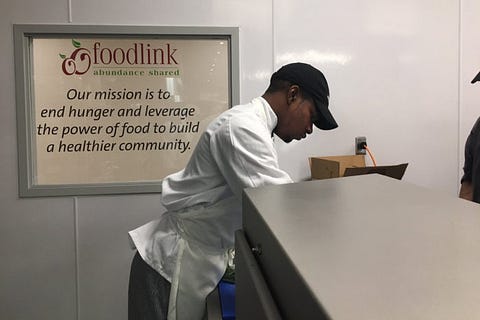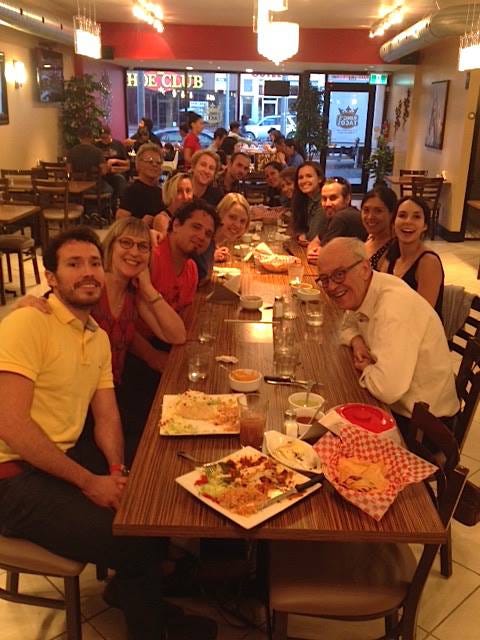CAN FOOD MOVEMENTS BE DESCRIBED AS MOVEMENTS FOR HUMAN LIBERATION?
Jonathan Latham has written a brief but enthusiastic piece (you can find it here) explaining why food movements are unstoppable movements for liberation.
Two strong claims — unstoppable and liberation. I’ve never seen food as a liberation movement before, and it took a while before I agreed that this is a powerful and unstoppable way of thinking about and relating to food movements.
Latham’s belief that food policies will change the world for the better is a new twist on the way we think about food. There are two reasons why this view is unusual. Both reasons relate to some powerful thought traps created by the forces behind the commanding heights of the food and health sectors.
Most of us in the Global North have come to think of food as a commodity wrapped up in relationships of self-interest. On one side are self-interested consumers, defined by the fact that they buy the commodity and want it for as little money as possible. On the other side are self-interested producers, who want the most for their food.
The word “consumer” assumes that people who buy and eat food are defined by a relatively passive role . They simply consume. They don’t have an active stake as eaters, citizens, community members or parents who are interested in food’s broader impacts. From that purely commercial or transactional starting point, there are no open-ended, common or public interests in food, just individual and conflicting self-interests.
If true, such relationships would have dire consequences for food’s likely impact on communities and cities.
Latham’s understanding goes far beyond that cash nexus. He’s equally at odds with the narrow and self-interested way most health professionals look at food. They see food as a storehouse of nutrients that promote health.
This “essentialist” and “reductionist” approach to food (to use academic jargon) does not envision food experiences as having significance for social and psychological health and well-being. Nor does this view appreciate health as more than a product of nutritional inputs. This narrow take on food has recently come to be identified as “nutritionism,” which I regard as the health parallel to the commodity fetishism promoted in the commercial view of food.
In both the commercial and health professional viewpoints, the social, emotional, environmental, economic and empowerment dimensions of food relationships are pushed aside.
Collateral damage from any such worldview inevitably undermines the possibility of city leaders adopting food as a project filled with opportunities for community economic development and the social economy. Nor would civic leaders identify food as a tool to overcome such harmful conditions as loneliness, hopelessness, demoralization, or disempowerment — all of which are rife in today’s cities.
Again, as someone keen on the positive contributions food can make to cities, I am drawn to Latham’s positioning of food as an open-ended and transformational force. We both stand against the tide of conventional assumptions linking food to narrow self-interest.
Choosing to see food through the lens of self-interest or mutual-interest may result from different understandings of human evolution and the qualities that allowed humans to triumph (if not yet succeed) as a species.
It’s unlikely that evolution selected humans who thought first and foremost about food as a way to improve conditions for other people and other species — upon that, we may all agree.
Basic survival and self-preservation are only the bare beginnings of the human story. It does not take long before the story takes a turn for the better. As the initial bonding between mother and infant during breastfeeding dramatizes, the impacts of food relationships are quickly and easily deepened, broadened and transformed during the course of life. Perhaps the aged mom who once devotedly breastfed her baby will end her time being fed by her devoted child, in a nursing home or hospital paid for by all those who understand their mutual interests in improving the world for everyone.
Food relationships have helped humans expand beyond basic survival and narrow self-interest. Human software comes with already-installed “apps” for empathy and collaboration. These apps make for more appetizing food movements with herbs and spices provided by empathy, liberation, and gusto.
So far, so good. I think Latham is right to see food as having game-changing significance for efforts to improve and renew a world that sustainably feeds all beings.
CONVIVIALITY & PLEASURE ARE AS GOOD AS FUEL & NUTRIENTS
A close second to the inborn physical need for food is our need for food experiences that nourish our mind and soul while sustaining us for the necessity of finding our next meal. More often than not, we will get to eat again because we evolved as social and pack animals, not lone wolves. The earliest hunters and gatherers huddled around a common fire to eat, to share, and to talk and plan. The next meals come from group efforts. That’s what kept the home fires alive and warm.
There are many reasons and consequences to fire’s historic role as the first human invention and tool. Fireplaces allowed us to cook food, which meant a wider range of foods could be rendered chewable, digestible, safe, pleasant and nutritious. And the fireplace at the center of the meal experience kept us in a circle around the same place where we ate, sharing the heat, light, and protection of the home fire. Fireplaces and circular, common ties remain universally understood metaphors of shared humanity to this day. In Canada, the French version of the national anthem refers to our home fires and our rights (“nos foyers et nos droits”), both depicted as foundations of a nation’s people standing together.
 The Rochester food bank, Foodlinks, understands food can be a lever. It provides food and also people-oriented services, including a new program to train people for cooking jobs.
The Rochester food bank, Foodlinks, understands food can be a lever. It provides food and also people-oriented services, including a new program to train people for cooking jobs.
This formative human experience of food eaten in a community around a common fire — not food to-go, or food gulped down as part of a hand-to-mouth existence — is where the slow food movement comes from. Eating as pals came with eating the paleo diet. Eating together was essential to food security. Without social capital, we would have fought each other over scraps of food instead of working together to make the fullest advantage out of each person’s optimal skillset. We wouldn’t have survived as a species if eating was wired to happen as lone individuals hoovered food over a sink, at a desk, or behind the wheel.
We all know deep-down that food is linked to connectedness. That is probably why we commonly begin important meals with a collective toast to everyone’s health and well-being, and a collective expression of other-centered humility and thanks paying tribute to all the contributions and connectivity that went into the meal.
That need for the community around food is almost as deep a driver of our behavior as our physical need for food’s fuel and nutrients. That is why humans are social animals, not the lean, lonely, self-maximizing animals depicted in conservative economic theory. It’s also key to the success of cities as exciting and productive places to develop our humanity.
The harmony between “lower” and “higher” human needs underlies the wisdom behind two ancient food habits — the design of meal experiences to produce shared pleasure and conviviality, and the design of socialization to imbed mutual interests and obligations among fellow hunters and gatherers and the environments they feed on.
That way of thinking about food and the human experience led me to develop and promote “people-centered food policy.”
One reason why I focus on food and city policy is that cities are both stronger and more vulnerable because they rely on interdependence for survival. Dealing with urban vulnerability doesn’t get much respect from politicians. Cities, towns, and villages are commonly put down as hosts of the “lower” levels of government — a strange way of describing levels of governments that depend on and must promote human cooperation.
By contrast, I would describe local governments as the higher level of government that deals with food as a people issue —creating opportunities to increase the capacity to respond to loneliness, neighborhood revitalization, community development, foundational economies, and social determinants of health.
Food can be multifunctional because it can produce both social bondingamong people of common families, neighborhoods, and heritage, and social bridging among people of diverse families, neighborhoods, and heritage. Such multifunctionality is enduring and liberating.

Jonathan Latham and Hather Lee enjoy a convivial moment after presenting on genetic engineering technologies at a January 2019 Guelph University conference on organic food. An unstoppable duo!
Near the top of his meditation, Latham says that “the food movement is unexpectedly radical.”
Food is radical because it teaches us to live in our gut, not just our head. The gut is as important to human evolution as the brain, and we need to show it that respect — not fill it with the cheapest junk we can find, which happens to be the most profitable way that global corporations have of producing it.
That shift to prioritizing the needs of our gut can be unexpectedly radical.
How might the world be redesigned if we took our integrated needs for nutrients, pleasure, and conviviality as the starting point for designs to manage our world?
FIVE FOOD SECRETS
Latham lists five hopeful qualities of food movements.
First, the movements are leaderless, he says.
At first glance, the advantages of that are hard to imagine. We usually think of centralized leadership as essential to good planning, strong organizations and winning campaigns. But overly-centralized organizations are prone to authoritarianism, as history has documented too many times.
Although the lack of formal leadership does create challenges in terms of being disciplined and effective as a striking force for change, such problems are more tolerable than suffering through centralized leadership. A partnership is a better ship to sail.
Second, the movement is grassroots, Latham says. Anyone who likes to eat is welcome. That’s also a good place to start, because it doesn’t attract the people who don’t like to eat — the people who fear food and worry about food, such as the kind of people who misled us for so long about fat in food, and the mad scientists who want re-engineer the world’s genes so we never run out of fake food. The road to food hell has been paved by people with tyrannical and sterile utopias based on fear of and dislike for “primitive” and “lowly” and “uncontrollable” food needs.
 farewell dinner for beloved co-worker put on by Mayan-inspired ChocoSol. Michael Sacco, leader of ChocoSol and coiner of the term “actionism, is third from the left, with a red Tshirt.
farewell dinner for beloved co-worker put on by Mayan-inspired ChocoSol. Michael Sacco, leader of ChocoSol and coiner of the term “actionism, is third from the left, with a red Tshirt.
Third, Latham says, food movements are open to learning from people around the world. That includes a few billion peasants, who for centuries have been scorned by Modernists — who scorned the deep wisdom that comes from dwelling in and on the land and water and in Nature.
Fourth, Latham says, food movements are low-budget and can often be sustained by people of limited means.
I think Latham could be more specific about this.
The quality we need to highlight is that food is directly empowering. It is within our immediate grasp to ask for fair trade coffee, cook from scratch, shop at farmers markets, start up a food policy council. Taking personal power — what I and my co-authors of Real Food for a Change, written way back in 1999, called The Power of One to Make a Difference — is an opportunity accessible to almost all people.
Food movements are low-budget precisely because they are directly empowering. They can be fueled by people power.
Fifth, Latham says, food leads us to have many values, based on many perspectives — including ethics, ecology, and justice. This leads people in food activities to make connections. That’s contrary to what Big Science, Big Money, and Big Government want us to do — which is to organize in departmentalized silos.
Food connects us all — this is the sentiment that really got me going in food movements, as you will see from this mannapesto I and others wrote in 2008.
TWO MORE QUALITIES OF FOOD MOVEMENTS
 That’s me, sitting in judgment — as one of a team of judges choosing the best bacon dish served at my local farmers market. Farmers markets are a way to get food into the city. They also serve up a heck of a lot of fun, connecting and socializing.
That’s me, sitting in judgment — as one of a team of judges choosing the best bacon dish served at my local farmers market. Farmers markets are a way to get food into the city. They also serve up a heck of a lot of fun, connecting and socializing.
I’ve heard that humans can remember a max of 7 things, so I’d like to ask Latham to add just two points to his list of five.
My nomination for point 6 is that food movements are solutionary. Critics and analysts are safely relegated to the sidelines. The people in front are the people doing things — not just protesting things, as many activists do, but doing things, as actionists do. To create the changes they want to see, actionists can start a community garden, start a food truck business, start a farmers market, start a direct trade chocolate social enterprise… I could go on and on and on, but more importantly, food actionists get started on solutions, not problems. It’s a movement of pro’s, not anti’s.
Being a solutionary movement means we carry ourselves as a positive and joyous force of nature. Many things about the world and about food can make us angry, but they do not require or justify negativity or hate. The food movement is unabashedly a movement of positive, joyful hope. We’re far sweeter than sugar!
Being a solutionary movement also means that food fits comfortably in partnerships with many, including local governments — often charged with humble things such as schools and streets and parks and neighborhoods, all of which work better when some version of food is at-hand; and all of which work best when there’s a partnership between citizen groups and government agencies.
The solutionary leaning of food makes it well-suited for local governments, which relies on an active citizenry for ideas and action. And the solutionary energy can course through every sort of issue — be it the need to uplift people from poverty or the need to manage existential threats to the environment.
My nomination for point 7 borrows from Latham’s point about the power of food to reframe.
Like many other deep thinkers, Latham heaps a lot of blame on the Enlightenment — — the 1600s and 1700s era when Europeans bit the apple of rational knowledge and started separating humans from the rest of Nature and life.
I think, therefore I am, said Descartes, who lost sight of the fact that he eats, therefore he is. Talk about living in your head!!
Lots can be said in favor of reason — it beats ignorant prejudice hands down — but the Age of Reason got a little unreasonable about merging calculation with Capital R Reason. That’s like equating speculation with land speculators.
Just ponder, for a moment, that the Age of Enlightenment coincided with the century when slave labor was used on a massive scale to make it profitable to grow, harvest and refine sugar and tobacco. The Enlightenment era often darkened the record of human history.
There’s a nice little trashing of rationalism in a review of a new book on The Enlightenment (note the Capital T in The) by, of all people, a former editor of the Economist, which is premised on calculating rationality.
Philosopher Thomas Nagel, writing in the New York Review of Books, says the mathematical and physics turn of mind common among Enlightenment thinkers (and classical economics, I would add) dehumanized reality.
Color, taste, feel, smell, sound — all the sensual things that make the food experience what it is — are invisibilized in order to make room for shape, size, and motion. Only measurable aspects qualify for what the physics geeks considered to be “primary” characteristics; all others are secondary characteristics.
That passage in the review of the Age of Reason hit me like a ton of bricks. All of a sudden, I realized why we have been pushing against a glass ceiling — not knowing why we could never get city officials, agriculture officials, medical officials, university officials, and so on — to take food seriously as a primary issue.
For them, food deals with secondary characteristics, and the primary characteristics should be left in the responsible hands of the anonymous market, Big Food companies and specialized government agencies.
 The Turin celebration of Terre Madre demonstrates artisan foods and food for thought
The Turin celebration of Terre Madre demonstrates artisan foods and food for thought
To love food is to understand why it’s important to steer a little clear of policy wonks — “fear the geeks, even bearing gifts.” Loving food experiences keeps conviviality, sensuality, holistic health, and well-being — the humble and lofty human needs and pleasures — at the forefront of our understanding.
Food not only meets our physical survival needs. It is also an existential force that helps define who we are — as individuals and as a species. That’s why food movements are both unstoppable and liberating.
If you like this item, please sign up for my free weekly (well, as close to weekly as I can) newsletter on food and city organizing hacks I’ve learned over the decades. Just go to https://wayneroberts.us12.list-manage.com/subscribe?u=ab7cd2414816e2a28f3b35792&id=1373397df7





